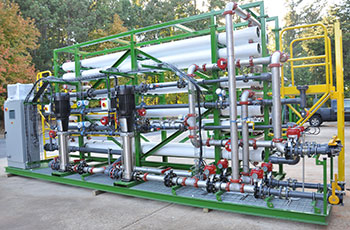Reverse Osmosis explained and usage
When pressure is added, to the higher level side, that is greater than the current osmotic pressure the flow will be reversed. This reversal allows the contaminant solution to be further concentrated and produces purified water. The adding of pressure to enact the reversal is called Reverse Osmosis or RO.

Pre-filtering out larger particles
Reverse Osmosis (RO) uses membranes with very small passageways and can thus be quickly clogged by attempting to process water with high turbidity. It is important to put in place a pre-filter before the RO with a larger pore size to capture these larger solids before they enter the RO system. Pre-filters such as bag filters are relatively inexpensive in comparison to RO so are an essential part of any RO design.
Desalination by Reverse Osmosis
- Saline feed water (sea water or brackish ground water)
- Low salinity produced water
- Brine or concentrated saline reject water
Desalination process
Pre-treatment
Pressurization
Separation
Post-treatment
The water can then be further treated for use as drinking (potable) water or other industrial uses requiring ultra-pure water.
Advantages of using Reverse Osmosis for Desalination
- RO technologies will remove organic and inorganic contaminants
- RO has a minimal environmental impact aside from the disposal of the produced brine
- RO can scale to an almost unlimited size making use of a near unlimited water source such as the ocean
- RO systems typically have minimal chemical usage
- RO systems are low maintenance due to use of mostly non-metal materials in construction

